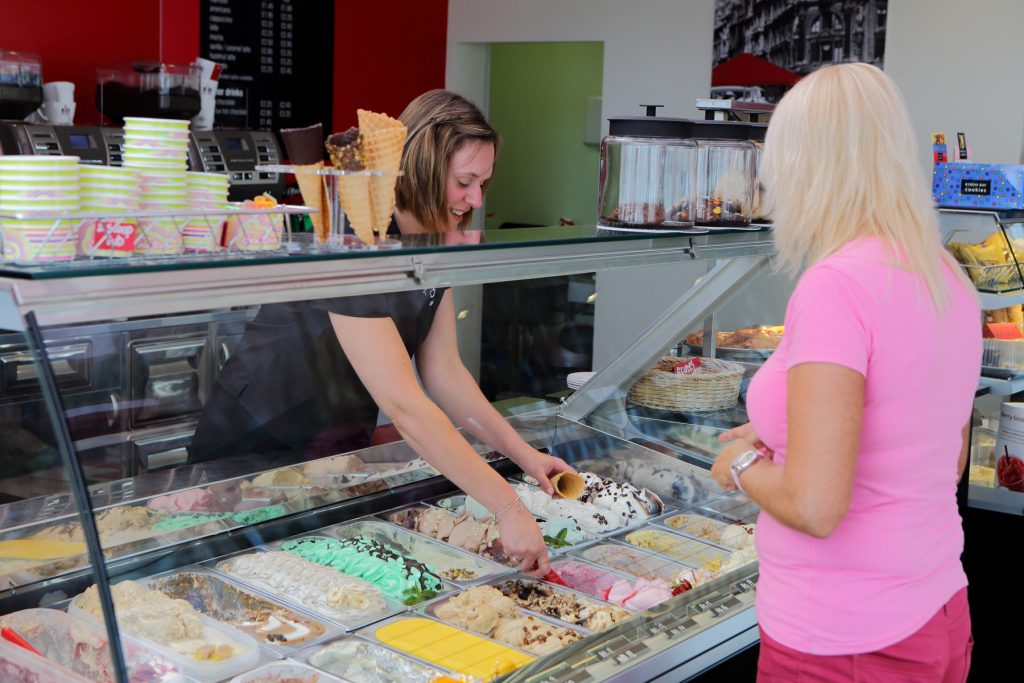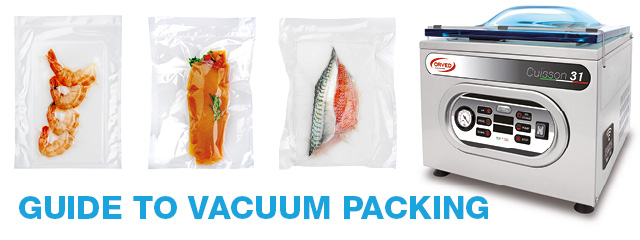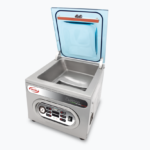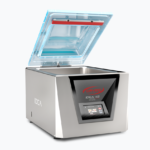Welcome to the Orved guide to Vacuum packing machines
Vacuum packing is a modern food packaging technique. It involves the extraction of the air contained within a package which is then hermetically sealed. The process removes oxygen and all of all the chemical and bacteriological contaminants normally present in the air, such as polluting compounds, bacteria and moulds, preventing them from coming into direct contact with the product.
Different vacuum levels can be used for different products. By simply adjusting the packing machine, according to the characteristics of the product to be packaged, you can achieve almost complete extraction of the air. This results in a residual oxygen value equal to one hundredth of the initial value. Any food product stored at low temperature and in a vacuum sealed package, maintains its colour, aroma and nutritional value for longer.
What are vacuum packing machines used for?
Maximising the hygiene and freshness of your products…
The main enemies of product quality are the oxygen contained in the air around us and microorganisms (bacteria and mould). Microorganisms are present everywhere in the environment, especially in kitchens, and can be found in storage containers, preparation machines, on operators’ hands, etc. etc. the list goes on.
Oxygen is an indispensable element for human and microorganism existence. It is a very reactive gas and is able to combine with the different substances contained in food products. When it reacts with food ingredients oxygen can cause negative changes in colour, taste and smell, compromising the quality and acceptability of the product.
Many of the microorganisms that can spoil food are aerobic, this means that they need an adequate amount of oxygen to live. Without it their proliferation is blocked and their activity of fermentation and degeneration of the food product is strongly inhibited.
Under vacuum packing conditions and at low temperatures, only a few microbial species can develop and they are anaerobic (don’t require oxygen to survive).
Removing the air from a package (therefore the oxygen contained within it) ensures a longer shelf-life of any degradable food product. It also ensures a better quality and real protection against accidental contamination.
Vacuum Packing for Food production..
Vacuum packing a food product immediately after its been made is the best way to preserve its quality and maintain its value.
By removing the air before it starts to deteriorate the food product either directly by drying, oxidizing, changing the smell. Or indirectly by promoting the development of bacteria, yeasts, moulds and their metabolites. Vacuum packing can maintain the quality of the product at the level reached during the original production process and will keep it intact until the moment of consumption.
Fresh food sales…
-
Providing an additional service to the customer – maximising shelf-life for the consumer
-
Adding value to the product – maintain the quality
-
Saving product shelf life during closing hours – prevent oxidation
-
Speed up serving times – pre-package items ready to simply grab and go
-
Reduce wastage – prevent unnecessary product degradation
Vacuum Packing for Restaurants…
Vacuum packing allows chefs to prepare elaborate and appetising foods well ahead of time. Protecting them from the potential damage that can be caused by air and time.
Removing the air from stored foods maintains the taste, smell, appearance and texture. It also prevents them from deteriorating over time.
Pre-portioning prepared foods like stews, confit, vegetables etc. allows chefs to maintain good stock control and reduce wastage. Individual portions can be reheated to order. Vacuum packing is ideal for use in combination with sous vide or bain marie cooking.
Butchers – fresh meats…
There are many reasons why fresh meat deteriorates during storage:
-
Multiplication of aerobic bacteria
-
The red colour of the meat turns brown
-
Deterioration of the fatty parts
-
Surface dehydration or drying
The elimination of air in a vacuum pack slows down of all of the above forms of quality degradation.
In a vacuum pack with little oxygen, harmful bacteria cannot multiply. This allows the lactic acid bacteria to take over which can improve the taste and texture of the meat. The fat component of the meat does not deteriorate which maintains flavour. Vacuum packing helps maintain product yield as the product does not dehydrate through evaporation or blood loss.
In the absence of oxygen, the meat will darken. But this phenomenon is temporary, as long as the meat is packaged immediately after cutting. As soon as the meat is exposed to air again, its colour returns creating an inviting appearance for the customer.
Vacuum Packing Cooked products…
Vacuum packaging is particularly good at slowing down any degenerative processes in cooked foods by eliminating oxygen and isolating the product in an airtight package. Vacuum sealing the product ensures that it does not take on any unwanted odour or dangerous contaminants.
Cheeses…
All cheeses, hard or soft, are easily subject to fungal contamination. Spores of mould are often present in the air of the environment and can easily proliferate on the surface of the cheese due to the high moisture content of these products. This is important during the cheese production process, but once the cheese has be made, these air borne contaminants can spoil the finished cheese.
Vacuum packing prevents damage to the appearance and smell of these products. The almost complete elimination of oxygen, which is essential for the growth of these micro-organisms, prevents deterioration. Vacuum packing prevents the drying of the surface of the cheese and the oxidative changes that can compromise the smell and aroma of the cheeses produced. As a result, the product maintains all of its characteristics and yield.
Vacuum packing and preservation at refrigeration temperatures are a great way to prolong the preservation of cheeses. This makes the distribution of whole or portioned cheeses easier and safer.
Processed meat…
The deterioration process of processed meat takes place in different ways: putrefactive phenomena, mould growth and greening can damage the preservation of processed meat. All these phenomena, whether chemical or biological, can be effectively combated through vacuum packing which eliminates contact with air.
The most important characteristics of these cured meats are their colour (pink or red), smell and fragrance. These qualities are effected by the level of oxygen present inside the package. Therefore, excluding air from the vacuum pack is the best guarantee to maintain the quality of the product.
Vacuum packing of processed meat is a packaging technique that has long been used successfully by all major food producers.
Confused? Contact the Taylor UK Sales Office to arrange free consultation with your local Sales Manager to make sure you understand all of the options and get the right machine for your business.
Call 0800 838 896, email sales@taylor-company.co.uk
or complete our Online Enquiry Form





















